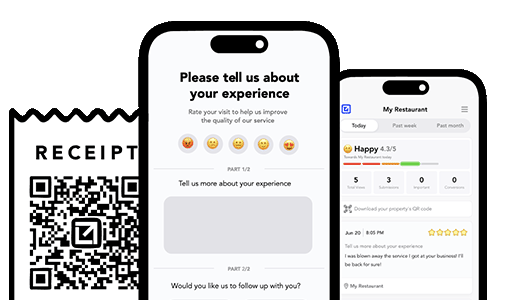Smart Ways to Get More Reviews [Guide]
Practical, proven ways for any business to get more authentic reviews.
![How to Get Your First Reviews [Guide] How to Get Your First Reviews [Guide]](https://images.unsplash.com/photo-1608748342407-df951916ccf4?q=80&w=1365&auto=format&fit=crop&ixlib=rb-4.1.0&ixid=M3wxMjA3fDB8MHxwaG90by1wYWdlfHx8fGVufDB8fHx8fA%3D%3D)
TLDR: If you run a great business but have no online reviews, you’re losing trust and customers. This guide shows how to get your first quality reviews without being awkward or breaking rules, why zero feedback kills credibility, and how to build both Google and Yelp profiles so you’re visible to everyone. You’ll also get proven tactics for collecting reviews organically with tools like VisibleFeedback.
Think about the last time you searched for a new place to eat, a new dentist, or even a car wash. If a business shows up with zero reviews, or just one from 2019, it doesn’t matter how great the service is. Most people scroll right past. That’s not because they’re judging your work. It’s because silence is suspicious. Today’s consumers are review-native. They expect a trail of social proof before they even consider walking through your door. Having no reviews is like throwing a party and forgetting to invite anyone. People assume no one else is showing up either. If you want to build trust, your first job is to prove that someone’s already been there, and had a great experience.
Not all review platforms are equal, and not all your customers are looking in the same place. If you’re starting from zero, the temptation is to go broad. Don’t. Start with two: Google and Yelp. These platforms dominate local search and map-based discovery. Google is the first stop for Android users, desktop searchers, and anyone using Chrome. Yelp, on the other hand, powers Apple Maps, Siri suggestions, and countless third-party apps. iPhone users don’t see your Google reviews when searching nearby. They see your Yelp score, whether you like Yelp or not. This split matters. If you only focus on one, you’re invisible to half the market. A smart review strategy starts by planting strong roots in both.
Asking for your first reviews can feel awkward. But it doesn’t have to. The key is to make it easy, casual, and part of the experience, not a favor. Here’s how to do it right:
Avoid review farms, bots, or mass incentives. They backfire fast and kill credibility. One real review from a happy customer is worth more than 50 fakes. And platforms are cracking down harder than ever.
The biggest mistake new businesses make is treating reviews like a one-time sprint. “Let’s get 10 and we’re done.” But the truth is: trust decays. A five-star review from two years ago feels stale. Your review strategy needs to be a living part of how you operate. Make reviews a routine, not a rescue plan. Train your staff to know when and how to ask. Bake review requests into your POS, your follow-ups, your loyalty emails. People don’t mind being asked if the experience was good, they just need a frictionless way to do it. When reviews are embedded in your operations, you don’t just get more reviews, you get better ones.
Once you’ve mastered the basics, getting more reviews the right way means building habits and systems that keep feedback flowing year-round without burning out your team.
Let’s say a customer has a great experience. That’s a golden opportunity, but don’t just hope they post somewhere useful. Give them direction. VisibleFeedback helps by capturing private feedback first, either via table cards, text prompts, or checkout screens, and then asking for a public review only if the guest is clearly happy. That way, your public footprint gets stronger without broadcasting every stumble. You can even choose which platform to steer them toward: Yelp, Google, Facebook, TripAdvisor. Over time, this fills in your weak spots. It’s not just review collection, it’s review strategy.
👉 Want to go deeper on using QR codes, follow-up messages, and staff habits to get reviews consistently? Check out our full guide on how to get more reviews.
Once you’ve earned 5–10 quality reviews, everything gets easier. People stop skipping your profile. Search engines give you more visibility. More guests walk in with confidence, and leave with praise. But momentum fades if you stop. The goal isn’t to reach a number and quit. It’s to keep the drumbeat going. Set a monthly goal. Celebrate new reviews with your team. Highlight good ones on your website, in emails, or on a review wall inside your business. Want to spark more reviews on slower days? Boost a Slow Wednesday walks through creative ways to turn quiet times into a steady stream of fresh feedback. When you treat reviews as a core part of how you operate, growth becomes predictable.
If you want to jumpstart that growth with smart prompts, private feedback tools, and routing that adapts to your weak spots, that’s what we built VisibleFeedback for. But whether you use us or not, start now. The sooner you seed your reputation, the sooner it grows into something real.
This article helped you get started, but if you’re ready to scale up, our flagship guide covers the full system: from when to ask, to automations, to filtering feedback smartly.

Bad reviews can scare away potential customers. Intercept feedback in real time with VisibleFeedback.

Austin Spaeth is the founder of VisibleFeedback, a simple tool that helps brick-and-mortar businesses intercept negative reviews before they go public. With a background in software development and a passion for improving customer experience, Austin built VisibleFeedback to give business owners a frictionless way to collect private feedback and turn unhappy visitors into loyal advocates. When he’s not working on new features or writing about reputation strategy, he’s probably wrangling one of his six kids or sneaking in a beach day.
Whether you have no reviews, bad ones, or great ones, we’ll help you turn your feedback into growth.
No credit card required.
⛨ Trusted by over 137 local businesses like yours